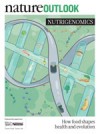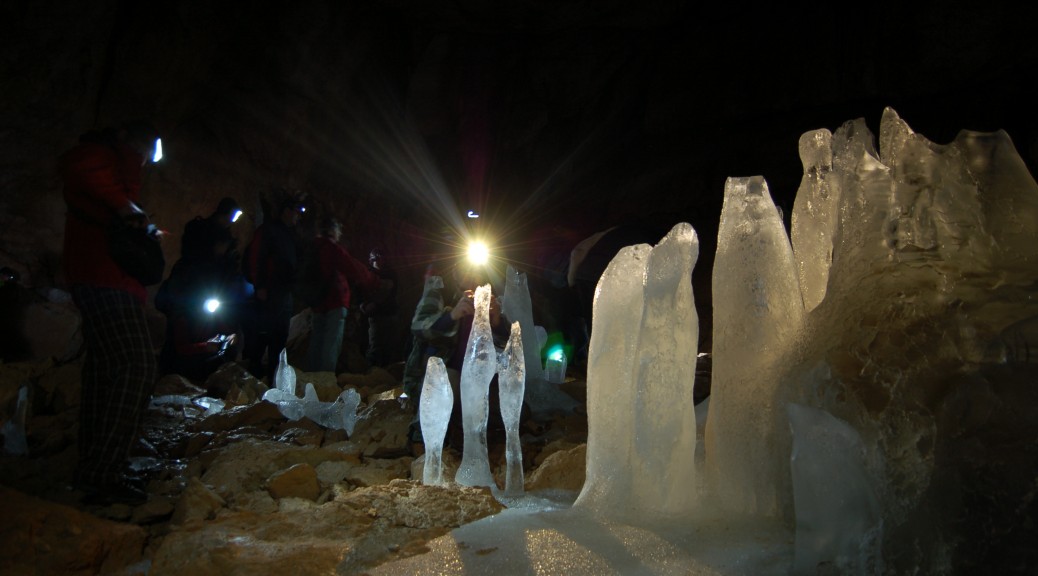Cape Town was filled with chattering Spanish researchers this week, on shore between legs of a circumnavigation that will take them from Cádiz to Sydney and back, by way of the Panama Canal. They chewed on biltong and rode the cable car to the top of Table Mountain. Now they are loading water sampling tubes and unpacking their laboratory equipment on the B.I.O. Hespérides, docked here in Cape Town until this afternoon, when we head for Perth. Continue reading Malaspina Expedition: Shipping out
Category Archives: Outlets
Caves of Ice: The Next Frontier in Paleoclimatology?
It’s early June in the Austrian Alps. Tourists in shorts sweat their way up a trail from the cable car above Lake Hallstatt. But the summer heat doesn’t stop a group of scientists from pulling on brightly colored jumpsuits over their hiking clothes at the entrance to Mammuthohle, one of the many limestone caves that riddle the Dachstein Massif. Lukas Plan, a geophysicist at the University of Vienna, straps on his headlamp and pauses to warn the crowd of researchers about the cave they are about to enter. It won’t just be chilly inside, he cautions; it will be an Alpine meat locker.
The crowd, part of the fourth international ice cave workshop organized by a network of European geophysicists and glaciologists, is gathered to visit the cave’s year-round ice formations.
Plan turns toward the tunnel in the mountainside and opens the metal door. A rush of wind bursts out. The group prepares to enter, hoping to read the history of the region’s climate in the cave’s ice.
Continue reading Caves of Ice: The Next Frontier in Paleoclimatology?
Peruvian biologist’s defamation conviction overturned
A defamation case that hinges on a dispute over the presence of genetic modification in Peruvian maize crops, and that has attracted international attention, has moved back to square one — with a twist.
Biologist Ernesto Bustamante Donayre was last April found guilty of defamation — a criminal offence in Peru — for publicly criticizing a report published by a fellow biologist. Last month, however, the conviction was overturned: the appeal judge found that a lower court had not demonstrated that Bustamante had sufficient motivation to harm or defame his alleged victim. A recent government study of the crops in question may shape the outcome of any subsequent proceedings, Bustamante says.
Continue reading Peruvian biologist’s defamation conviction overturned
Big science at the table
 José Ordovas sips a mint tea in a languid café in Madrid, Spain. His eyes scan two mobile phones as he confirms his next appointments. In conversation, he switches effortlessly between Spanish and English to find the right expressions. If the geneticist seems to be moving on a different wavelength from the other patrons, he could blame it on the jet lag: he has just flown from Boston where it’s now 5am. This is his third overseas trip this month, but Ordovas contends his frequent visits from Tufts University, where he’s based, to Europe have no adverse effects. “For me the time difference doesn’t matter, I’m up at 4am to make calls to Europe when I’m home anyway, and then I’m up late on calls to California,” he says.
José Ordovas sips a mint tea in a languid café in Madrid, Spain. His eyes scan two mobile phones as he confirms his next appointments. In conversation, he switches effortlessly between Spanish and English to find the right expressions. If the geneticist seems to be moving on a different wavelength from the other patrons, he could blame it on the jet lag: he has just flown from Boston where it’s now 5am. This is his third overseas trip this month, but Ordovas contends his frequent visits from Tufts University, where he’s based, to Europe have no adverse effects. “For me the time difference doesn’t matter, I’m up at 4am to make calls to Europe when I’m home anyway, and then I’m up late on calls to California,” he says.
Ordovas embodies the hustle and bustle of the ‘big science’ approach that has changed nutrition research in the past decade. This field, once confined to small groups of researchers studying the effects of single nutrients — such as particular vitamins or proteins — on a few dozen volunteers, is now adopting the heavy-lifting tools developed for genetics and pharmaceutical research. It also has a catchy name: nutrigenomics. And the more that researchers learn how our genes interact with our diet, the more they appreciate the deeper insight gained by an interdisciplinary approach. Such knowledge could lead to breakthroughs in our understanding of risk factors for diabetes and cardiovascular disease or, for example, improve the design of weight-loss diets.

